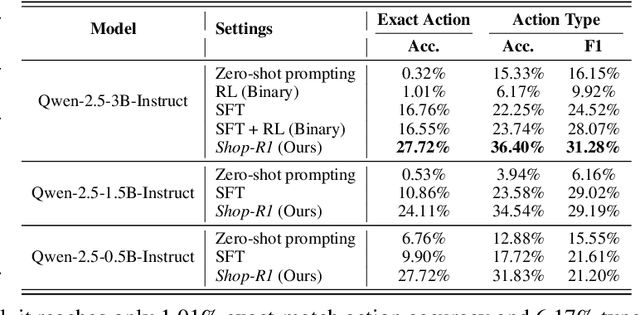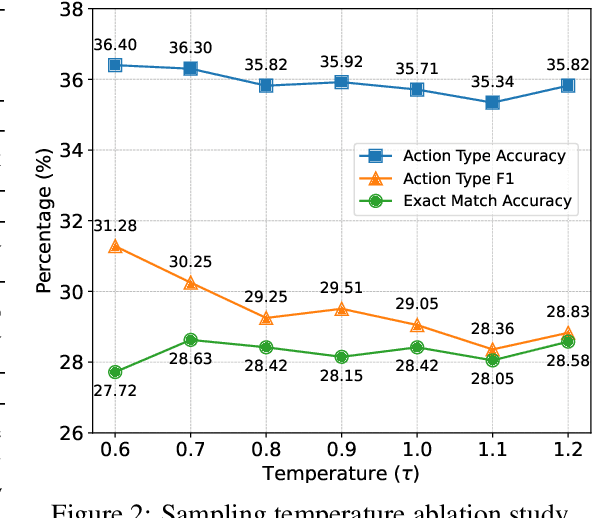Kun Qian
DocRefine: An Intelligent Framework for Scientific Document Understanding and Content Optimization based on Multimodal Large Model Agents
Aug 09, 2025Abstract:The exponential growth of scientific literature in PDF format necessitates advanced tools for efficient and accurate document understanding, summarization, and content optimization. Traditional methods fall short in handling complex layouts and multimodal content, while direct application of Large Language Models (LLMs) and Vision-Language Large Models (LVLMs) lacks precision and control for intricate editing tasks. This paper introduces DocRefine, an innovative framework designed for intelligent understanding, content refinement, and automated summarization of scientific PDF documents, driven by natural language instructions. DocRefine leverages the power of advanced LVLMs (e.g., GPT-4o) by orchestrating a sophisticated multi-agent system comprising six specialized and collaborative agents: Layout & Structure Analysis, Multimodal Content Understanding, Instruction Decomposition, Content Refinement, Summarization & Generation, and Fidelity & Consistency Verification. This closed-loop feedback architecture ensures high semantic accuracy and visual fidelity. Evaluated on the comprehensive DocEditBench dataset, DocRefine consistently outperforms state-of-the-art baselines across various tasks, achieving overall scores of 86.7% for Semantic Consistency Score (SCS), 93.9% for Layout Fidelity Index (LFI), and 85.0% for Instruction Adherence Rate (IAR). These results demonstrate DocRefine's superior capability in handling complex multimodal document editing, preserving semantic integrity, and maintaining visual consistency, marking a significant advancement in automated scientific document processing.
Shop-R1: Rewarding LLMs to Simulate Human Behavior in Online Shopping via Reinforcement Learning
Jul 23, 2025



Abstract:Large Language Models (LLMs) have recently demonstrated strong potential in generating 'believable human-like' behavior in web environments. Prior work has explored augmenting training data with LLM-synthesized rationales and applying supervised fine-tuning (SFT) to enhance reasoning ability, which in turn can improve downstream action prediction. However, the performance of such approaches remains inherently bounded by the reasoning capabilities of the model used to generate the rationales. In this paper, we introduce Shop-R1, a novel reinforcement learning (RL) framework aimed at enhancing the reasoning ability of LLMs for simulation of real human behavior in online shopping environments Specifically, Shop-R1 decomposes the human behavior simulation task into two stages: rationale generation and action prediction, each guided by distinct reward signals. For rationale generation, we leverage internal model signals (e.g., logit distributions) to guide the reasoning process in a self-supervised manner. For action prediction, we propose a hierarchical reward structure with difficulty-aware scaling to prevent reward hacking and enable fine-grained reward assignment. This design evaluates both high-level action types and the correctness of fine-grained sub-action details (attributes and values), rewarding outputs proportionally to their difficulty. Experimental results show that our method achieves a relative improvement of over 65% compared to the baseline.
PerfTracker: Online Performance Troubleshooting for Large-scale Model Training in Production
Jun 12, 2025



Abstract:Troubleshooting performance problems of large model training (LMT) is immensely challenging, due to unprecedented scales of modern GPU clusters, the complexity of software-hardware interactions, and the data intensity of the training process. Existing troubleshooting approaches designed for traditional distributed systems or datacenter networks fall short and can hardly apply to real-world training systems. In this paper, we present PerfTracker, the first online troubleshooting system utilizing fine-grained profiling, to diagnose performance issues of large-scale model training in production. PerfTracker can diagnose performance issues rooted in both hardware (e.g., GPUs and their interconnects) and software (e.g., Python functions and GPU operations). It scales to LMT on modern GPU clusters. PerfTracker effectively summarizes runtime behavior patterns of fine-grained LMT functions via online profiling, and leverages differential observability to localize the root cause with minimal production impact. PerfTracker has been deployed as a production service for large-scale GPU clusters of O(10, 000) GPUs (product homepage https://help.aliyun.com/zh/pai/user-guide/perftracker-online-performance-analysis-diagnostic-tool). It has been used to diagnose a variety of difficult performance issues.
Bottom-Up Synthesis of Knowledge-Grounded Task-Oriented Dialogues with Iteratively Self-Refined Prompts
Apr 19, 2025Abstract:Training conversational question-answering (QA) systems requires a substantial amount of in-domain data, which is often scarce in practice. A common solution to this challenge is to generate synthetic data. Traditional methods typically follow a top-down approach, where a large language model (LLM) generates multi-turn dialogues from a broad prompt. Although this method produces coherent conversations, it offers limited fine-grained control over the content and is susceptible to hallucinations. We introduce a bottom-up conversation synthesis approach, where QA pairs are generated first and then combined into a coherent dialogue. This method offers greater control and precision by dividing the process into two distinct steps, allowing refined instructions and validations to be handled separately. Additionally, this structure allows the use of non-local models in stages that do not involve proprietary knowledge, enhancing the overall quality of the generated data. Both human and automated evaluations demonstrate that our approach produces more realistic and higher-quality dialogues compared to top-down methods.
Evaluation and Incident Prevention in an Enterprise AI Assistant
Apr 11, 2025



Abstract:Enterprise AI Assistants are increasingly deployed in domains where accuracy is paramount, making each erroneous output a potentially significant incident. This paper presents a comprehensive framework for monitoring, benchmarking, and continuously improving such complex, multi-component systems under active development by multiple teams. Our approach encompasses three key elements: (1) a hierarchical ``severity'' framework for incident detection that identifies and categorizes errors while attributing component-specific error rates, facilitating targeted improvements; (2) a scalable and principled methodology for benchmark construction, evaluation, and deployment, designed to accommodate multiple development teams, mitigate overfitting risks, and assess the downstream impact of system modifications; and (3) a continual improvement strategy leveraging multidimensional evaluation, enabling the identification and implementation of diverse enhancement opportunities. By adopting this holistic framework, organizations can systematically enhance the reliability and performance of their AI Assistants, ensuring their efficacy in critical enterprise environments. We conclude by discussing how this multifaceted evaluation approach opens avenues for various classes of enhancements, paving the way for more robust and trustworthy AI systems.
Rec-R1: Bridging Generative Large Language Models and User-Centric Recommendation Systems via Reinforcement Learning
Mar 31, 2025



Abstract:We propose Rec-R1, a general reinforcement learning framework that bridges large language models (LLMs) with recommendation systems through closed-loop optimization. Unlike prompting and supervised fine-tuning (SFT), Rec-R1 directly optimizes LLM generation using feedback from a fixed black-box recommendation model, without relying on synthetic SFT data from proprietary models such as GPT-4o. This avoids the substantial cost and effort required for data distillation. To verify the effectiveness of Rec-R1, we evaluate it on two representative tasks: product search and sequential recommendation. Experimental results demonstrate that Rec-R1 not only consistently outperforms prompting- and SFT-based methods, but also achieves significant gains over strong discriminative baselines, even when used with simple retrievers such as BM25. Moreover, Rec-R1 preserves the general-purpose capabilities of the LLM, unlike SFT, which often impairs instruction-following and reasoning. These findings suggest Rec-R1 as a promising foundation for continual task-specific adaptation without catastrophic forgetting.
Contrastive Speaker-Aware Learning for Multi-party Dialogue Generation with LLMs
Mar 11, 2025Abstract:Multi-party dialogue generation presents significant challenges due to the complex interplay of multiple speakers and interwoven conversational threads. Traditional approaches often fall short in capturing these complexities, particularly when relying on manually annotated dialogue relations. This paper introduces Speaker-Attentive LLM (SA-LLM), a novel generative model that leverages pre-trained Large Language Models (LLMs) and a speaker-aware contrastive learning strategy to address these challenges. SA-LLM incorporates a speaker-attributed input encoding and a contrastive learning objective to implicitly learn contextual coherence and speaker roles without explicit relation annotations. Extensive experiments on the Ubuntu IRC and Movie Dialogues datasets demonstrate that SA-LLM significantly outperforms state-of-the-art baselines in automatic and human evaluations, achieving superior performance in fluency, coherence, informativeness, and response diversity. Ablation studies and detailed error analyses further validate the effectiveness of the proposed speaker-attentive training approach, highlighting its robustness across different speaker roles and context lengths. The results underscore the potential of SA-LLM as a powerful and annotation-free solution for high-quality multi-party dialogue generation.
Text-to-SQL Domain Adaptation via Human-LLM Collaborative Data Annotation
Feb 21, 2025Abstract:Text-to-SQL models, which parse natural language (NL) questions to executable SQL queries, are increasingly adopted in real-world applications. However, deploying such models in the real world often requires adapting them to the highly specialized database schemas used in specific applications. We find that existing text-to-SQL models experience significant performance drops when applied to new schemas, primarily due to the lack of domain-specific data for fine-tuning. This data scarcity also limits the ability to effectively evaluate model performance in new domains. Continuously obtaining high-quality text-to-SQL data for evolving schemas is prohibitively expensive in real-world scenarios. To bridge this gap, we propose SQLsynth, a human-in-the-loop text-to-SQL data annotation system. SQLsynth streamlines the creation of high-quality text-to-SQL datasets through human-LLM collaboration in a structured workflow. A within-subjects user study comparing SQLsynth with manual annotation and ChatGPT shows that SQLsynth significantly accelerates text-to-SQL data annotation, reduces cognitive load, and produces datasets that are more accurate, natural, and diverse. Our code is available at https://github.com/adobe/nl_sql_analyzer.
MAD-UV: The 1st INTERSPEECH Mice Autism Detection via Ultrasound Vocalization Challenge
Jan 08, 2025


Abstract:The Mice Autism Detection via Ultrasound Vocalization (MAD-UV) Challenge introduces the first INTERSPEECH challenge focused on detecting autism spectrum disorder (ASD) in mice through their vocalizations. Participants are tasked with developing models to automatically classify mice as either wild-type or ASD models based on recordings with a high sampling rate. Our baseline system employs a simple CNN-based classification using three different spectrogram features. Results demonstrate the feasibility of automated ASD detection, with the considered audible-range features achieving the best performance (UAR of 0.600 for segment-level and 0.625 for subject-level classification). This challenge bridges speech technology and biomedical research, offering opportunities to advance our understanding of ASD models through machine learning approaches. The findings suggest promising directions for vocalization analysis and highlight the potential value of audible and ultrasound vocalizations in ASD detection.
Bridging the Data Provenance Gap Across Text, Speech and Video
Dec 19, 2024



Abstract:Progress in AI is driven largely by the scale and quality of training data. Despite this, there is a deficit of empirical analysis examining the attributes of well-established datasets beyond text. In this work we conduct the largest and first-of-its-kind longitudinal audit across modalities--popular text, speech, and video datasets--from their detailed sourcing trends and use restrictions to their geographical and linguistic representation. Our manual analysis covers nearly 4000 public datasets between 1990-2024, spanning 608 languages, 798 sources, 659 organizations, and 67 countries. We find that multimodal machine learning applications have overwhelmingly turned to web-crawled, synthetic, and social media platforms, such as YouTube, for their training sets, eclipsing all other sources since 2019. Secondly, tracing the chain of dataset derivations we find that while less than 33% of datasets are restrictively licensed, over 80% of the source content in widely-used text, speech, and video datasets, carry non-commercial restrictions. Finally, counter to the rising number of languages and geographies represented in public AI training datasets, our audit demonstrates measures of relative geographical and multilingual representation have failed to significantly improve their coverage since 2013. We believe the breadth of our audit enables us to empirically examine trends in data sourcing, restrictions, and Western-centricity at an ecosystem-level, and that visibility into these questions are essential to progress in responsible AI. As a contribution to ongoing improvements in dataset transparency and responsible use, we release our entire multimodal audit, allowing practitioners to trace data provenance across text, speech, and video.
 Add to Chrome
Add to Chrome Add to Firefox
Add to Firefox Add to Edge
Add to Edge